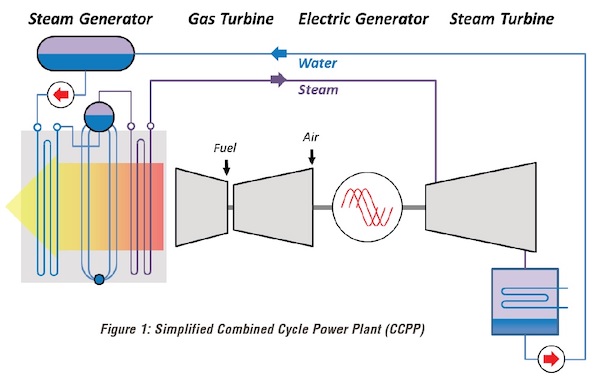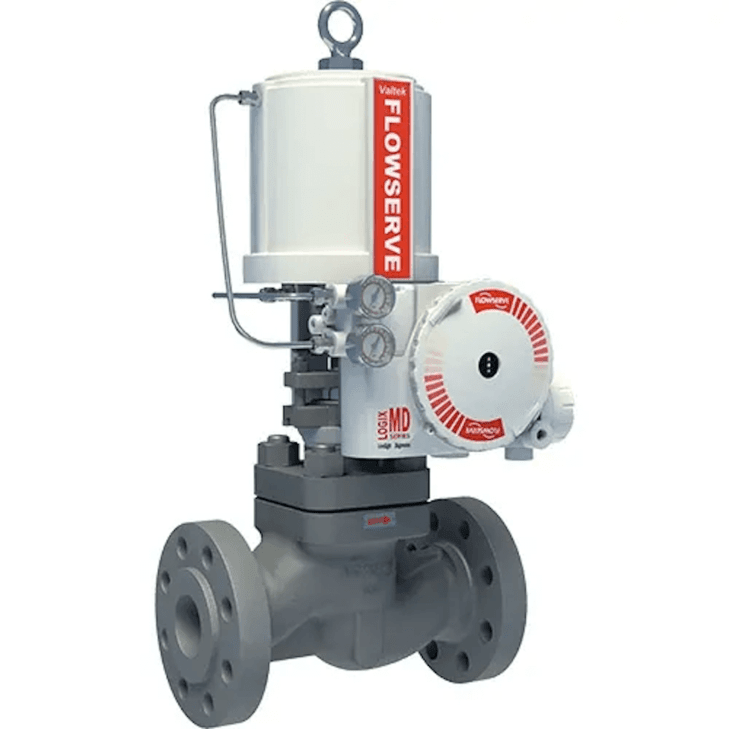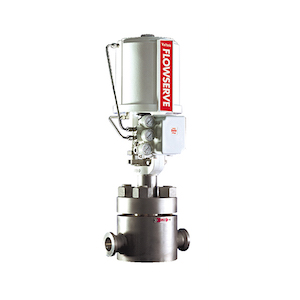Flowserve Valves for the Combined Cycle Industry
Since the introduction of the third generation GE F-Class gas turbine in 1990, the combined cycle power generation industry has grown steadily, with ever larger and more efficient plants. Combined cycle technology has completely supplanted conventional steam generation technology for gas-fired power generation applications.
- Integrated Gasification Combined Cycle (IGCC) plants, which convert coal or heavy oil to gas that can be used in a combined cycle plant, are already in operation and will eventually become competitive with conventional supercritical coal-fired plants.
- Combined cycle plants can also be integrated with Concentrated Solar Power (CSP) plants, significantly reducing the cost of the renewable energy generated by the CSP plant.
According to the IEA World Energy Outlook 2016, global gas-fired generating capacity increased 7% in 2014 and 2015, and the IEA is forecasting that gas-fired capacity additions between 2016 and 2025 will be ahead of coal. The major portion of these capacity additions will come from combined cycle generation. This combined cycle capacity will come from new installations as well as the conversion of existing simple cycle installations.

Key to the success of these plants, Flowserve valves have offered low-cost, high-efficiency solutions for the industry since the very beginning.
Flowserve Valve Benefits for the Combined Cycle Industry
Flowserve has been a leader in combined cycle power generation since the process was commercialized on a large scale. This experience has been built into today’s valve products, increasing reliability, maintainability and product life.
- Flowserve manufactures to the most rigorous quality standards to provide reliable products.
- Engineering excellence shows in the optimized product and material selection for each application, which contributes to reliable operation.
- Safety is ensured through Flowserve’s considerable experience in valve manufacturing and pioneering service to the power industry. Flowserve’s product designs consider industry standards and low-risk design factors and maintainability to maximize MTBF.
A Quick Look at Flowserve Valves for Combined Cycle Plants
Combined cycle plants offer difficult challenges for valves, including high operating temperatures and pressures. Combined cycle plants are also expected to handle rapid variations in load and may be required to start and stop frequently. Flowserve offers a portfolio of valves designed to handle severe transient operating conditions.
A typical combined cycle plant may have more than 5000 valves. The largest quantity of these are small bore general service valves. Flowserve valves that are often specified for critical service applications include:
- Valtek® globe control valves
- Valtek Valdisk™ double offset butterfly valves
Valves for Combined Cycle
Below are some of the major critical service valve applications in a combined cycle plant, and the Flowserve valves most commonly specified for these applications.
The following Flowserve products handle most of the on-off applications:
Valdisk BX Double-Offset Butterfly Valves
The following Flowserve products handle most control valve applications:
LP Feedwater Control Valve
The LP feedwater control valve controls the water level in the LP steam drum. The valve is subject to cavitation at low flow during plant startup and must have high rangeability. It must provide accurate level control in the LP steam drum with low-pressure drop during normal full load operation. The valve can be located upstream of the LP economizer, or it can also be located downstream to maintain the economizer at a higher pressure to avoid steaming at off-design conditions.
FLOWSERVE SOLUTION: Valtek Mark One or Mark 100 with CavControl anti-cavitation trim.
Condensate Extraction Pump Recirculation Valve
This is a similar application as the main feed pump recirculation valve, but the operating conditions are more moderate.
FLOWSERVE SOLUTION: Valtek Mark One™ or Mark 100 with ChannelStream or DiamondBack anti-cavitation trim.
Main Feed Pump Recirculation Valve
The feed pump recirculation valve is intended to ensure the required minimum flow through the feed pump to prevent excessive temperature rise, flow recirculation damage and hydraulic instability. Minimum flow requirements can vary, depending on the design and power of the pump. Each feed pump must have a dedicated recirculation valve. Earlier plants used an on/off valve for this application, but modulating control valves are now most common.
During normal operation, at full load the valve remains closed and must seal tightly against a differential pressure. Any leakage will result in energy losses and damage to the trim, so these valves are equipped with hardened metal seating surfaces of Class V sealing trim.
These valves are usually equipped with sophisticated anti-cavitation trim to handle the high differential pressures when the valve is modulating. It’s important to understand the application and various operating conditions to properly size the valve.
Flowserve solutions are preferable to the alternative approach of an Automatic Recirculation Valve (ARV), a self-actuated valve with an integral check valve. ARVs have several disadvantages, including:
- higher-pressure losses
- mechanical linkages in the flow path that wear
- leakage during normal operation when the valve is closed
- flow cannot be monitored or flow settings altered during operation
FLOWSERVE SOLUTION: Valtek Mark One or Mark 100 with ChannelStream and DiamondBack anti-cavitation trim.
IP and HP Feedwater Control Valves
The flow from each feed pump discharge is regulated by a control valve to maintain the correct flow and control the level of feedwater in the intermediate- and high-pressure steam drums. They operate at low flows and high-pressure drops during startup and are subject to cavitation. Under normal plant operation, the valves should have a low-pressure drop to minimize losses. Accurate control of feedwater flow at all operating conditions must be maintained. In some cases, a smaller startup valve is installed in parallel with the main valve.
FLOWSERVE SOLUTION: Valtek Mark One or Mark 100 with CavControl anti-cavitation trim.
Start-up Vent (Sky Vent) Control Valve
The gas turbine in a combined cycle plant can come up to full speed and load quickly, but the HRSG, steam turbine and condenser require more gradual loading to avoid thermal transients that could cause damage. The startup (or sky vent) system allows for controlled loading of the plant by venting steam to the atmosphere. Valves are normally provided on the HP superheater outlet and hot reheat line. These valves must be able to operate with minimum noise with high-pressure drops and ensure tight sealing when closed.
FLOWSERVE SOLUTION: Valtek Mark One and Mark 100 with MegaStream, TigerTooth or Stealth noise reduction trim.
Super Heater and Reheater Attemperator Spray Valves
Attemperators are used to control the temperature of superheated steam going to the steam turbine by injecting feedwater or condensate through nozzles in the steam line. The attemperator nozzles are designed to ensure complete mixing and rapid vaporization of the spray water. Accurate control is essential to protect the turbine from overheating without impairing plant efficiency or allowing water droplets to form that might cause damage to turbine blades.
Attemperator spray valves control the flow of water to the attemperators. These valves require high rangeability, tight shutoff (Class V) and must provide long service life. Water is supplied from the discharge of the main feed pumps.
FLOWSERVE SOLUTION: Valtek Mark One with CavControl or SideWinder anti-cavitation trim.
HP, IP and LP Turbine Bypass Spray Water Valves
These spray water valves provide water to the steam conditioning bypass valves. The water for the HP bypass is provided by the main feedwater pump, while the supply for the IP and LP bypass is provided by the condensate extraction pump. The valves must provide accurate control and provide tight shutoff.
FLOWSERVE SOLUTION: Valtek Mark One with CavControl or SideWinder anti-cavitation trim.
Condenser Cooling Water Pump Butterfly Valve
Generally, a quick opening double-offset butterfly valve is used for these applications. In seawater applications, the valves would need to be made of duplex or super-duplex.
FLOWSERVE SOLUTION: Valdisk double-offset BX butterfly valves.
Service Water Pump Butterfly Valve
Service water may be provided by dedicated service water pumps or from a takeoff line from the discharge of the main condenser cooling water pumps. The valve construction would be similar to what is provided for the condenser cooling pumps, but would have a much smaller diameter.
FLOWSERVE SOLUTION: Valdisk double-offset BX butterfly valves.
Summary
With the continued growth in combined cycle power generation, reliable valves are essential at nearly every step in the process. Flowserve has been a leader in the power generation industry for close to 100 years, and a partner with combined cycle power generation since the process was just beginning. Flowserve valves offer low-cost, high-efficiency solutions for the future of the combined cycle power industry.
*All information sourced from Flowserve



